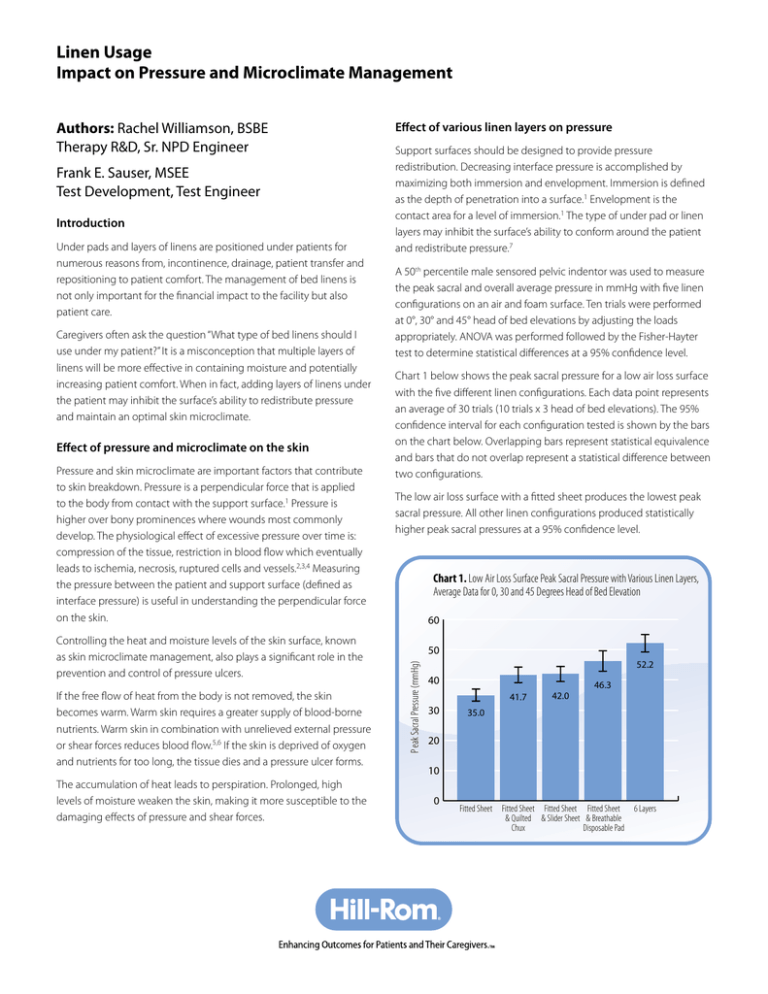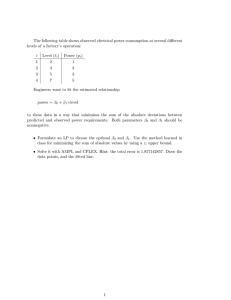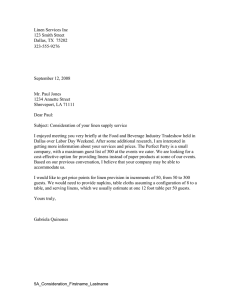
Linen Usage
Impact on Pressure and Microclimate Management
Under pads and layers of linens are positioned under patients for
numerous reasons from, incontinence, drainage, patient transfer and
repositioning to patient comfort. The management of bed linens is
not only important for the financial impact to the facility but also
patient care.
Caregivers often ask the question “What type of bed linens should I
use under my patient?” It is a misconception that multiple layers of
linens will be more effective in containing moisture and potentially
increasing patient comfort. When in fact, adding layers of linens under
the patient may inhibit the surface’s ability to redistribute pressure
and maintain an optimal skin microclimate.
Effect of pressure and microclimate on the skin
Pressure and skin microclimate are important factors that contribute
to skin breakdown. Pressure is a perpendicular force that is applied
to the body from contact with the support surface.1 Pressure is
higher over bony prominences where wounds most commonly
develop. The physiological effect of excessive pressure over time is:
compression of the tissue, restriction in blood flow which eventually
leads to ischemia, necrosis, ruptured cells and vessels.2,3,4 Measuring
the pressure between the patient and support surface (defined as
interface pressure) is useful in understanding the perpendicular force
on the skin.
Controlling the heat and moisture levels of the skin surface, known
as skin microclimate management, also plays a significant role in the
prevention and control of pressure ulcers.
If the free flow of heat from the body is not removed, the skin
becomes warm. Warm skin requires a greater supply of blood-borne
nutrients. Warm skin in combination with unrelieved external pressure
or shear forces reduces blood flow.5,6 If the skin is deprived of oxygen
and nutrients for too long, the tissue dies and a pressure ulcer forms.
A 50th percentile male sensored pelvic indentor was used to measure
the peak sacral and overall average pressure in mmHg with five linen
configurations on an air and foam surface. Ten trials were performed
at 0°, 30° and 45° head of bed elevations by adjusting the loads
appropriately. ANOVA was performed followed by the Fisher-Hayter
test to determine statistical differences at a 95% confidence level.
Chart 1 below shows the peak sacral pressure for a low air loss surface
with the five different linen configurations. Each data point represents
an average of 30 trials (10 trials x 3 head of bed elevations). The 95%
confidence interval for each configuration tested is shown by the bars
on the chart below. Overlapping bars represent statistical equivalence
and bars that do not overlap represent a statistical difference between
two configurations.
The low air loss surface with a fitted sheet produces the lowest peak
sacral pressure. All other linen configurations produced statistically
higher peak sacral pressures at a 95% confidence level.
Chart 1. Low Air Loss Surface Peak Sacral Pressure with Various Linen Layers,
Average Data for 0, 30 and 45 Degrees Head of Bed Elevation
60
50
52.2
40
41.7
30
42.0
46.3
35.0
20
Overall Average Pressure (mmHg)
Introduction
Support surfaces should be designed to provide pressure
redistribution. Decreasing interface pressure is accomplished by
maximizing both immersion and envelopment. Immersion is defined
as the depth of penetration into a surface.1 Envelopment is the
contact area for a level of immersion.1 The type of under pad or linen
layers may inhibit the surface’s ability to conform around the patient
and redistribute pressure.7
10
The accumulation of heat leads to perspiration. Prolonged, high
levels of moisture weaken the skin, making it more susceptible to the
damaging effects of pressure and shear forces.
0
Fitted Sheet Fitted Sheet Fitted Sheet Fitted Sheet 6 Layers
& Quilted & Slider Sheet & Breathable
Chux
Disposable Pad
Chart 3. Standard Foam Surface Peak Sacral Pressure with Various Linen
Layers, Average Data for 0, 30 and 45 Degrees Head of Bed Elevation
60
Hg)
50
56.3
Hg)
Frank E. Sauser, MSEE
Test Development, Test Engineer
Effect of various linen layers on pressure
P eak Sacral Pressure (mmHg)
Authors: Rachel Williamson, BSBE
Therapy R&D, Sr. NPD Engineer
Chart 2. Low Air Loss Surface Overall Average Pressure with Various
Linen Layers, Average Data for 0, 30 and 45 Degrees Head of Bed Elevation
20
21.3
15
21.9
22.5
23.8
Chart 3. Standard Foam Surface Peak Sacral Pressure with Various Linen
Layers, Average Data for 0, 30 and 45 Degrees Head of Bed Elevation
19.3
60
10
50
5
0
Fitted Sheet Fitted Sheet Fitted Sheet Fitted Sheet 6 Layers
& Quilted & Slider Sheet & Breathable
Chux
Disposable Pad
56.3
49.0
40
30
48.9
49.1
42.1
20
10
The 50th percentilel male sensored pelvic indentor images below show
the increase
pressure
thePressure
additional
linenLinen
layers
on a
Chartin4.interface
Standard Foam
Surfacewith
Overall
with Various
Layers,
low air loss
surface
bed elevation.
Average
Data at
for 30°
0, 30head
and 45ofDegrees
Head of Bed Elevation
Overall Average Pressure (mmHg)
30
25
20
25.3
Low air loss surface
15
with fitted sheet
27.3
27.7
29.3
27.3
Low air loss surface with
fitted sheet and breathable
disposable pad
Low air loss surface
with 6 linen layers
10
5
0
Fitted Sheet Fitted Sheet Fitted Sheet Fitted Sheet 6 Layers
& Quilted & Slider Sheet & Breathable
Chux
Disposable Pad
0
Fitted Sheet Fitted Sheet Fitted Sheet Fitted Sheet 6 Layers
& Quilted & Slider Sheet & Breathable
Chux
Disposable Pad
Overall Average Pressure (mmHg)
Overall Average Pressure (mmHg)
25
P eak Sacral Pressure (mmHg)
yers,
Overall Average Pressure (mmHg)
The low air loss surface with only a fitted sheet produced the lowest
overall average pressure. All configurations tested were statistically
equivalent at a 95% confidence level.
Chart 3 shows the peak sacral pressure on a standard foam surface
with the
60five different linen configurations. Each data point represents
an average of 30 trials (10 trials x 3 head of bed elevations). The 95%
confidence
50 interval for each configuration tested is shown by the bars
52.2 equivalence
on the chart below. Overlapping bars represent statistical
40that do not overlap represent a statistical
and bars
46.3 difference between
42.0
41.7
two configurations.
30
35.0
A standard foam surface with only a fitted sheet produced the
lowest 20
peak sacral pressure, which was 42.1mmHg. All other linen
configurations produced statistically higher peak sacral pressures at
a 95% confidence
level. An air product with Advanced Microclimate
10
Technology™ surface with a fitted and slider sheet also produced a
0 pressure of 42.0mmHg. Therefore, by adding an additional
peak sacral
Fitted Sheet Fitted Sheet Fitted Sheet Fitted Sheet 6 Layers
& Quilted
& Slider Sheet
& Breathable Technology™,
layer to the air product with
Advanced
Microclimate
Chux
Disposable Pad
the peak sacral pressures become equivalent to a foam surface with a
fitted sheet.
P eak Sacral Pressure (mmHg)
Chart 2 below shows the overall average pressure over the entire
pelvic indentor for the low air loss surface with the linen layer
configurations. Again, each data point represents an average of
30 trials (10 trials x 3 head of bed elevations). The 95% confidence
interval for each configuration tested is shown by the bars on the
chart below. Overlapping bars represent statistical equivalence and
bars that do not overlap represent a statistical difference between two
configurations.
Chart 1. Low Air Loss Surface Peak Sacral Pressure with Various Linen Layers,
Average Data for 0, 30 and 45 Degrees Head of Bed Elevation
Overall Average Pressure
15
19.3
10
Chart 4 below shows the overall average pressure on a standard
5
foam surface with five different linen configurations. Each data point
represents an average of 30 trials (10 trials x 3 head of bed elevations).
The 95%0confidence
for each
configuration
Fitted Sheetinterval
Fitted Sheet
Fitted Sheet
Fitted Sheet tested
6 Layers is shown
&
Quilted
&
Slider
Sheet
&
Breathable
by the bars on the chart below. Overlapping bars represent statistical
Chux
Disposable Pad
equivalence and bars that do not overlap represent a statistical
difference between two configurations.
Chart 4. Standard Foam Surface Overall Pressure with Various Linen Layers,
Average Data for 0, 30 and 45 Degrees Head of Bed Elevation
Overall Average Pressure (mmHg)
30
25
20
25.3
27.3
27.7
29.3
27.3
15
10
5
0
Fitted Sheet Fitted Sheet Fitted Sheet Fitted Sheet 6 Layers
& Quilted & Slider Sheet & Breathable
Chux
Disposable Pad
The standard foam surface with only a fitted sheet produced the
lowest overall average pressure. All configurations tested were
statistically equivalent at a 95% confidence level.
The 50th percentile male sensored pelvic indentor images below show
the increase in interface pressure with the additional linen layers on a
standard foam surface at 30° head of bed elevation.
Effect of various linen layers on thermal performance
Low air loss surfaces should be designed to maintain the skin
temperature and humidity within a target range to keep the skin cool
and dry.8 Low air loss surfaces are defined as ‘a feature of a support
surface that provides a flow of air to assist in managing the heat and
humidity (microclimate) of the skin’.1 This is achieved by effectively
removing excess heat and moisture from the patient’s skin. The type of
under pad or linen layers may impede the air flow to the patient’s skin,
restrict the flow of heat from the body into the surface or reduce the
ability to evaporate moisture.
The support surface’s ability to withdrawal heat and moisture was
measured using an Advanced Thermal Mannequin, which is a
technique adapted from the outdoor garment industry known as the
sweating guarded hot plate method. The device was positioned in the
seat section and weighted appropriately for a 50th percentile male. Six
dry and six wet trials were performed at 0° head of bed elevation with
six linen configurations.9
The dry condition represents surface’s the ability to dissipate heat
when no moisture is present. The wet condition, in which the
environment under the test plate is at 100% relative humidity,
represents additional heat loss due to evaporation. The evaporative
capacity is calculated from the wet flux, which is in units of watts
per square meter, and reported as grams per square meter hour. The
evaporative capacity quantifies the surface’s ability to remove moisture.
Chart 5 below shows the total heat withdrawal and evaporative
capacity of a low air loss surface with various linen configurations.
The higher the total heat withdrawal and evaporative capacity value,
the better the surface’s ability to withdraw heat and moisture from
the patient.
The quilted chux and multiple layers greatly reduce the surface’s ability
to remove heat and moisture, which may lead to an increase in skin
temperature and humidity. The total heat withdrawal of a standard
foam surface is 12.9W/sqm and 1.0 g/sqmhr for evaporative capacity.
Chart 5. Low Air Loss Surface Thermal Performance with Various
90 Linen Layers
Standard foam surface
with fitted sheet
Standard foam surface
with fitted sheet and
breathable disposable pad
Standard foam surface
with 6 linen layers
80
Total Heat Withdrawal Capacity (W/sqm)
82.4
75.6
70
Evaporative Capacity (g/sqmhr)
74.0
60
61.9
50
40
30
24.6
20
32.0
33.8
29.1
21.1
25.0
10
0
12.9
2.0
Fitted Sheet
3.6
Fitted Sheet Fitted Sheet Fitted Sheet Fitted Sheet 6 Layers
& Breathable & Slider Sheet & Maximum & Quilted Chux
Disposable Pad
Strength
Disposable Pad
1.0
Standard
Foam
Surface
Below are infrared images that show the skin temperature distribution
of a 5'2" 135 lb. female after 3 hours lying supine at 30° head of bed
elevation on an air product with Advanced Microclimate Technology™
with a fitted sheet and 6 linen layers. The additional linen layers
impede the surface’s ability to withdraw heat away from the body.
An infrared image of the same test subject on a standard foam surface
is also shown for comparison.
Conclusion
Pressure and skin microclimate are critical factors that contribute
to skin breakdown. Depending upon the linen used, peak sacral
interface pressure can increase from 7-17mmHg. This difference in
interface pressure can decrease a dynamic multi-zoned air product
performance to the same level as a foam surface. In terms of heat
and moisture withdrawal, the slider sheet and breathable disposable
pads did not significantly impact performance. By adding a quilted
chux or various layers of linens the heat and moisture withdrawal
performance of the product decreased to the same level as a non low
air loss surface with a topper foam.
It is important to understand the function of the linen and impact to
the patient’s skin to minimize the risk of breakdown.
Low air loss surface with fitted sheet
References
1 National Pressure Ulcer Advisory Panel (2006). Standardized Terms and Definitions for the Support
Surface Industry
2 Agency for Health Care Policy Research (1994). Clinical Practice Guideline: Treatment of Pressure Ulcers.
AHCPR Publication No. 95-0652.
3 NHS Centre for Reviews and Dissemination, University of York, Nuffield Institute for Health, University of
Leeds. The Prevention and Treatment of Pressure Ulcers. Effective Health Care; October 1995, Volume 2,
Number 1.
4 Reswick, J. B., and Rogers, J. E. (1976). Experience at Rancho Los Amigos Hospital with Devices and
techniques to Prevent Pressure Sores. In Kenedi, R. M., Cowden, J. M. (Eds.), Bedsore Biomechanics,
Baltimore, MD, University Park Press, 301 – 310.
Low air loss surface with 6 linen layers
5 Kokate, JY, Leland, KH, Held, AM, Hansen, GL, Kveen, GI, Johnson, BA, et al. “Temperature-Modulated
Pressure Ulcers: A Porcine Model.” Arch. Phys Med Rehabil. 1995:76:666-673.
6 Iazzio, P., “Temperature Modulation of Pressure Ulcer Formation: Using a Swine Model”. Medscape Today,
(from WebMD): Wounds. Volume 18, posted Sept. 2004.
7 Williamson, R., Sauser, F. (2008) Interface Pressure Testing. Hill-Rom Test Requests T20080571,
T20080692.
8 Lachenbruch, C. (2008) Microclimate Management, So much more than airflow… 153374 rev 2.
9 Williamson, R., Williams, J. (2008) Thermal Testing. Hill-Rom Test Request T20080853.
6 Layers of Linen:
Standard foam surface with fitted sheet
Fitted Sheet
Bath Blanket
Flat Sheet in Quarters
Quilted Chux
Bath Blanket
Quilted Chux
Hill-Rom reserves the right to make changes without
notice in design, specifications and models. The only
warranty Hill-Rom makes is the express written warranty
extended on the sale or rental of its products.
© 2009 Hill-Rom Services, Inc. ALL RIGHTS RESERVED.
156445 rev 1 1/21/09
USA 800-445-3730
Canada 800-267-2337
www.hill-rom.com





